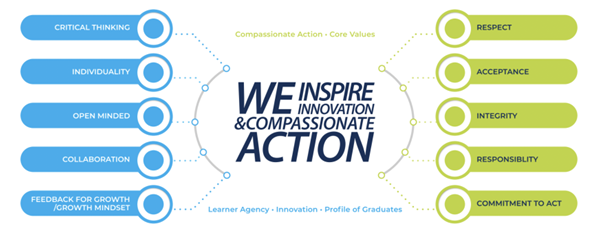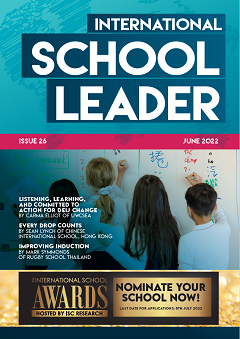By Richard Charlesworth
Our mission at Sara Village School is ‘We Inspire Innovation and Compassionate Action’. Our work integrating empathy into our curriculum, and our celebration of Empathy Week, has been a key strategy in our efforts to live our mission.
Introducing empathy
Empathy Week’s initial programme invites students to consider the lives and experiences of others through a series of thought-provoking videos focused on real individuals around the world. Students use empathy as a lens through which they analyse and discuss the situations they see and hear to further build their understanding and compassion. This initial stage takes a week.
Over the next five weeks the students begin a series of weekly lessons with the aim of developing empathy for themselves and for others. The final stage involves the students engaging in an empathy action project. Students and teachers are guided through workbooks and online sessions to help bring their knowledge and understanding of empathy into real-world actions. They document their work in videos and presentations and share it with the community and other schools around the world.
Recognition for our initiative
Sara Village School engaged fully with the Empathy Week programme and in the summer of 2022 we received the Outstanding Primary Award at the Global Empathy Awards. During the event, the students presented their action research project to the judges outlining the ways in which they increased empathy within the community. This was the culmination of a year’s worth of hard work and dedication by all students and staff towards the goal of developing a more compassionate and caring community.
Winning this award was a great achievement, but better than the award is the positive impact this work has had on the students and staff at the school. There is a palpable sense of kindness in the classrooms. You can see and hear it when you walk through the corridors. Students care for each other in deeper, more meaningful ways.
Subsequently, we discovered that Empathy Week conducted a pilot study with the University of Cambridge investigating how effective the Empathy Week programme is at developing the skill of empathy. The research found that students were more responsive to the feelings of others and displayed increased emotional empathy; they were able to demonstrate signs of increased self-compassion and heightened self-esteem and were seen to display a greater desire to care for and connect with others.
Our progressive steps
As we reflect on the empathy journey we have been on we have recognised a few key elements that helped us to achieve our positive outcomes. Although this list is not exhaustive, we hope that it may help other educators build empathy or other skills development into their schools and communities.
1. Start with your mission
Any new initiative should be in line with the mission and guiding principles of the organisation. Sara Village School’s mission is ‘We Inspire Innovation and Compassionate Action’. The explicit links between our mission, guiding principles (core values and profile of graduates) and strategic goals (increased learner agency and compassionate action) can be seen in the graphic below.
Credit: Romy Alcoriza, ISG Creative Designer
We were able to clearly link our work on empathy with many key elements of our mission and guiding principles, such as inspiring compassionate action, critical thinking, responsibility, open-mindedness and a commitment to act. This ensured that the activities, communication and messaging around the empathy-based initiatives were consistent and contributed towards our commitment to our values as an organisation. Working with Empathy Lab, Empathy Week and participating in the Global Empathy Awards helped to both inspire our work and raise its profile for the students and within the community.
2. Focus
In education, there are a plethora of initiatives, resources, tools, ideas and strategies that are great. The difficulty lies in deciding on which ones to focus on. A common reason for initiatives failing at the schools I have worked in is that when a new initiative is introduced an old one is not taken away, it creates an ever-increasing pile of great things we would all like to do but don’t have the time to focus on in any depth. Staff become disengaged and there is no buy-in to new initiatives.Find one initiative that aligns with the values of your organisation and clearly communicate the vision of the initiative to the staff. Build momentum through the enthusiasm of proactiveness of the early adopting members of staff and start to get buy-in. Crucially, focus on this one thing and remove obstacles for staff in the form of other half-adopted initiatives that are lingering. This will elevate the importance of this initiative and help to build long-lasting buy-in. For us, empathy resonated with our students and staff and clearly linked to our mission and values.Whilst writing this I realised how closely this connects with Kotter’s eight-step model for change, which I would recommend reading if ever engaging in an adaptive change such as this.
3. Embed it in the curriculum
Each week our learning support teacher created a lesson on empathy, which she would differentiate and deliver to every class. Over the course of the year the situations became more complex, requiring the students to reflect more deeply and compassionately. During the week, the stories were reinforced by being referenced in assemblies, being referred to by specialist teachers and brought up in different contexts by the class teachers.New initiatives need time to work. Embedding our empathy work into our curriculum and linking it with our literacy strategies meant that there was time and space for it to flourish. Referring to the work at key moments during the week helped to reinforce the message with the students, creating a system-wide approach. This helped teachers to view the work as an important component of their job and not as an additional responsibility to add to the list.
“Embedding our empathy work into our curriculum meant that there was time and space for it to flourish.”
4. Empower students as decision-makers
Our next step was to think about how we could give students the opportunity to apply their learning in the real world and enact some change within our community. Thinking of our strategic goal to increase learner agency and compassionate action and of our core value of a ‘commitment to act’, students were able to make choices and decisions about how we could, as a school, be more empathetic in the community. They identified groups and individuals within the community for charitable support; they identified the need for a playground buddy system to help those who didn’t have someone to play with; they brought greater awareness and recognition to the different nationalities and cultures within the school; and they raised money for causes in different parts of the world. They made all of these decisions, not the teachers.Empowering the students to make decisions and to have authorship over the projects increased engagement and ultimately led to richer learning experiences. The students were not just responsible for the projects, they owned them.
5. Celebrate often
Celebrations not only feel good, they reinforce the work and the message. They recognise the progress and highlight the benefits to all of our choice of focus. It is a time that demonstrates that we all care, which can be a useful reminder to all.Overall, through our collective commitment to explore and develop the skill of empathy in collaboration with Empathy Week, we truly live our mission.

Richard Charlesworth is Principal at Sara Village School. Connect with him on LinkedIn. You can learn more about Sara Village School’s empathy initiative here.



